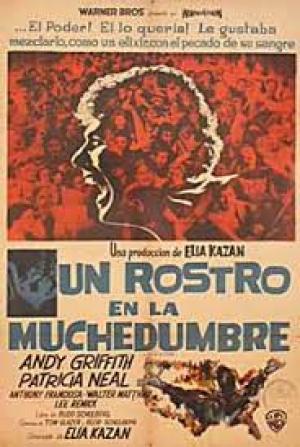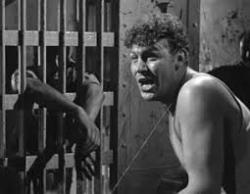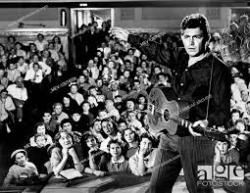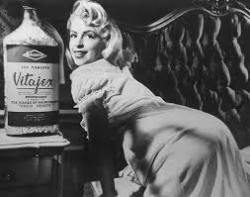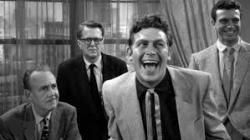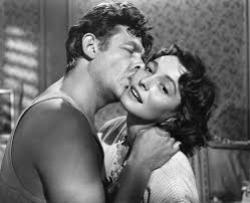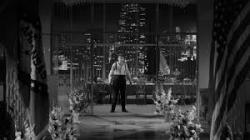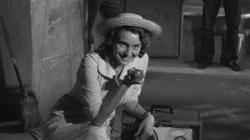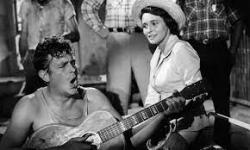Reality TV bites
By Michael J Roberts
"I truly believe that all power corrupts. Such is probably the thinking behind every political film ever made in Hollywood." ~ Elia Kazan
Elia Kazan and Budd Schulberg bonded with the magnificent On The Waterfront, over their shared riposte to the wrench HUAC caused to their life and careers, and to the condemnation from some quarters (including many old friends) of their ‘naming names’. On The Waterfront framed the stool pigeon as hero, affirming that ‘ratting’ on ones colleagues was not always a bad thing, and both Kazan and Schulberg were able to maintain successful careers in the films wake, notwithstanding that equating the Mob to the US Communist Party was a false equivalence of epic proportions. A Face In The Crowd is their response to the power of the media, something they experienced first-hand during the hearings, and to the rise of demagogues like Joseph McCarthy, as well as to the lingering stench of HUAC - an unpleasant odour that would hang around the pair for the rest of their lives.
Marcia (Patricia Neal) is a field reporter for a local radio station in a small town in Arkansas, where she stumbles upon a vagrant, Larry Rhodes (Andy Griffith) in a prison cell as she’s recording her show, A Face In The Crowd. She christens him Lonesome and records his homespun philosophies and earthy blues which is so well received by her audience that he’s offered a slot at the station. Soon Lonesome has outgrown his local following and is making waves in the region and then thanks to his notoriety and his self-appointed slippery agent Joey (Tony Franciosa), he hits the national airwaves via a New York TV show. Marcia follows him to New York, by this time deeply in love with the mercurial singer, even though the thoughtful Mel (Walter Matthau) cautions against her committing to so temperamental a talent. Soon the back-room moneymen convince the star into using his popularity in the political realm by backing their pick for presidential candidate, Senator Fuller. Lonesome soon grasps the extent of his influence and the possibilities that outsized fame and influence could bring.
At the heart of America’s Judeo-Christian modern founding is the inherited core idea of the ‘messiah’, the ‘one’ who will arrive with all the answers, and in many ways this is Kazan’s variation on the messiah theme. Schulberg wrote a short story, Your Arkansas Traveller, in 1953, prior to On The Waterfront, and in honing it as a screenplay with Kazan they came up with a sort of Meet John Doe for the Golden Age of TV era, with a sympathetic gal reporter in love with an ordinary man duped by bigger interests. In Riskin and Capra’s story the dupe retains his common-man dignity and integrity, but in Kazan’s cynical satire no such luck, Lonesome becomes loathsome. Kazan’s tone is more in keeping with a Billy Wilder helmed observation on good old American values, and like Wilder’s harder edged works it struggled to find contemporary acceptance.
In 1950 only 10% of households had a television in America, but by the end of the decade that number was exponentially higher at 80%, so the reach and influence of the medium was a relatively new thing. Schulberg and Kazan spent months researching Madison Ave advertising methods, rightly recognising that television was the ideal method to sell almost anything to mainstream America, anything including lies and snake oil. The country was then enjoying an unprecedented consumerist boom post-WWII, benefiting the middle class with median incomes growing six-fold in a dozen years. In many aspects the film was well ahead of its time, but in nailing the unholy alliance between advertising and mainstream TV it shines brightest. The wit and satire employed surrounding Lonesome’s central product Vitajex, (essentially a version of Viagra 40 years ahead of time) is darkly comic, but the fact that the advertising paymasters could effectively limit and censor content via their advertising dollar is more stealthily handled.
Kazan stated that he modelled Lonesome on the TV personality Arthur Godfrey, the Evangelist Billy Graham, and Will Rogers and in Andy Griffith he found someone who could readily embody a part of each. Griffith had rose to prominence via some comedy work and a Broadway hit, No Time For Sergeants, which had brought him to Kazan’s attention and his film debut. Kazan realised that a big part of Griffith’s personality was an overarching urge to be liked, so he used several techniques to break down the actor’s reserve and extracted a performance where Griffith’s natural charm was underpinned by a sense of threat and manipulative menace. Griffith went on to famously play gentle, benign characters from small town America and was beloved by generations of TV viewers as Sheriff Andy Taylor in the long running Andy Griffith Show, but in his debut, he revealed a capacity for playing complex, conflicted roles that was very much against type. Griffith had experience of evangelists and at one time had studied to be a preacher himself, and in Lonesome’s desperate, energetic preacher mode he channels them ferociously. Griffith manages a layered performance with his stunning characterisation of the ravenous, yet always empty star.
Patricia Neal was a Tony award winning Broadway actress set for a stellar film career after making a splash with The Fountainhead opposite Gary Cooper in 1949, but her affair with her very married co-star subsequently led to an abortion, break up and nervous breakdown for the accomplished young woman. After recovering, she worked again on Broadway and in a string of unremarkable features until Kazan cast the 31year-old as the stoic Marcia where her vulnerable and memorable performance marked her ascension to the first rank of character actresses in American film. Neal’s performance is the human heart of the piece, where Marcia exhausts every avenue in helping redeem the unruly Lonesome, until she realises that she has to betray him for the greater good. Neal is ably abetted in her work by the always wonderful Walter Matthau (in only his 4th film), another Broadway star who would go on to enjoy a significant feature film career.
Elia Kazan’s attention to detail and his ability to extract great performances from all of his cast makes A Face In The Crowd stellar entertainment. Tony Franciosa is note perfect as the lugubrious agent and Lee Remick makes a nice mark in her debut film. Kazan was an unpleasant and driven individual, but an astute and supremely gifted artist who was at the peak of his powers in 1957. Both he and Schulberg were right to be suspicious of the power of TV in the political arena as only a couple of years later the photogenic John Kennedy won enough of an edge over the sweaty Richard Nixon in the first ever televised debates to claw to a narrow victory. That fact changed American politics forever and strategists would put TV performance and image at the top of their candidate’s list of desired attributes until a vacuous reality TV star would accidentally stumble to Presidential electoral victory in 2016. That result proved that Democracy, like every other product in consumerist America, can be brought, and that the mythical 'great good sense' of the common man cannot always be relied upon.
Kazan was no angel, but he was a fierce character with a keen intellect, not afraid to kick against the pricks even when his aim was misdirected, and his motives misguided. He never took a backward step in relation to his notorious 'naming names,' and took any modicum of success as a badge of survival, a marker of revenge at the part of the industry that scorned him, even until his controversial honorary Oscar in 1999. A Face in The Crowd is in the top rank of his work, a masterful examination of the power of media and a timely reminder that fame and superficial surface gloss is no substitute for the hard graft of proper policy and the work of a skilled and educated bureaucracy to enact it.
